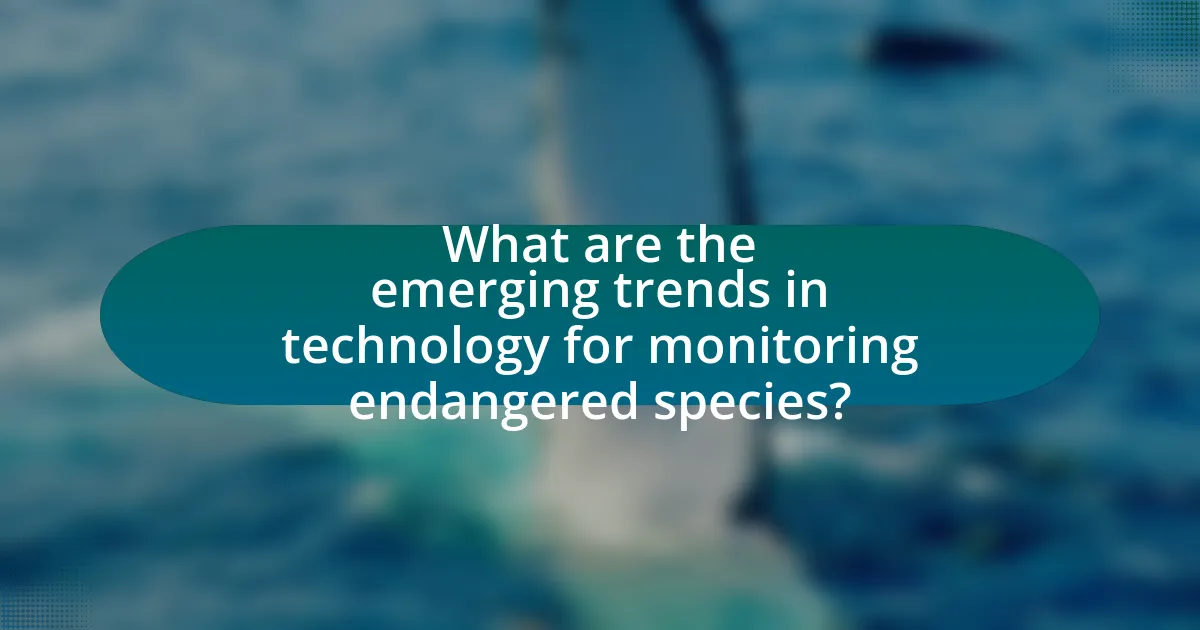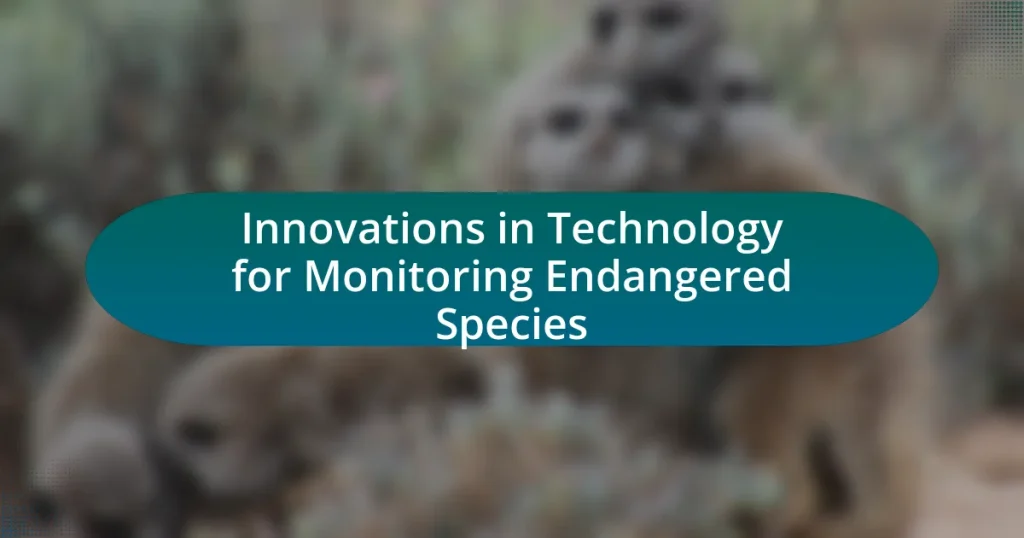Innovations in technology for monitoring endangered species encompass various advanced tools such as drones, camera traps, and bioacoustic monitoring systems. These technologies enhance data collection and analysis, allowing researchers to track animal populations, behaviors, and habitat conditions with greater accuracy and efficiency. Key advancements include GPS tracking for real-time location data, camera traps for non-invasive wildlife observation, and artificial intelligence for improved data processing. The article explores how these technologies contribute to effective conservation strategies, the challenges they face, and best practices for their implementation in wildlife monitoring efforts.

What are Innovations in Technology for Monitoring Endangered Species?
Innovations in technology for monitoring endangered species include the use of drones, camera traps, and bioacoustic monitoring systems. Drones equipped with high-resolution cameras allow researchers to survey large areas quickly and gather data on animal populations and habitats without disturbing them. Camera traps, which are motion-activated, provide continuous monitoring of wildlife and can capture images of elusive species, contributing to population assessments. Bioacoustic monitoring systems utilize sound recordings to detect and analyze animal calls, enabling researchers to track species presence and behavior over time. These technologies enhance data collection efficiency and accuracy, supporting conservation efforts effectively.
How have technological advancements changed the landscape of wildlife monitoring?
Technological advancements have significantly transformed wildlife monitoring by enhancing data collection, analysis, and accessibility. Innovations such as GPS tracking, remote sensing, and camera traps allow researchers to gather real-time data on animal movements, behaviors, and populations with unprecedented accuracy. For instance, GPS collars provide precise location data, enabling the study of migration patterns and habitat use, while camera traps facilitate the monitoring of elusive species without human interference. Additionally, the integration of artificial intelligence in data analysis streamlines the processing of large datasets, improving the efficiency of wildlife studies. These advancements have led to more informed conservation strategies and better protection of endangered species, as evidenced by successful tracking and management programs implemented in various ecosystems worldwide.
What specific technologies are being utilized in monitoring endangered species?
Specific technologies utilized in monitoring endangered species include GPS tracking, camera traps, acoustic monitoring, and satellite imagery. GPS tracking allows researchers to gather real-time location data on animals, enhancing understanding of their movements and habitat use. Camera traps capture images of wildlife, providing insights into species presence and behavior without human interference. Acoustic monitoring employs sound recording devices to detect and analyze animal calls, which is particularly useful for elusive or nocturnal species. Satellite imagery offers a broad view of habitat changes and landscape alterations, aiding in conservation planning. These technologies collectively enhance data collection and analysis, facilitating more effective conservation strategies.
How do these technologies improve data collection and analysis?
Innovations in technology, such as remote sensing, GPS tracking, and machine learning, significantly enhance data collection and analysis for monitoring endangered species. These technologies enable real-time data acquisition, allowing researchers to gather precise information on animal movements, habitat use, and population dynamics. For instance, GPS collars provide accurate location data, which can be analyzed to understand migration patterns and habitat preferences. Additionally, machine learning algorithms can process large datasets efficiently, identifying trends and anomalies that may not be apparent through traditional analysis methods. This integration of advanced technologies leads to more informed conservation strategies and improved outcomes for endangered species.
Why is monitoring endangered species crucial for conservation efforts?
Monitoring endangered species is crucial for conservation efforts because it provides essential data on population dynamics, habitat use, and threats, enabling targeted interventions. Accurate monitoring allows conservationists to assess the effectiveness of management strategies, adapt to changing conditions, and prioritize resources effectively. For instance, studies have shown that tracking the population trends of species like the Amur leopard has led to focused conservation actions that increased its numbers from around 30 individuals in the early 2000s to over 100 today. This data-driven approach ensures that conservation efforts are based on empirical evidence, ultimately enhancing the chances of species recovery and ecosystem stability.
What role does technology play in enhancing conservation strategies?
Technology plays a crucial role in enhancing conservation strategies by providing advanced tools for monitoring and protecting endangered species. For instance, satellite imagery and drones enable conservationists to track wildlife movements and habitat changes in real-time, allowing for timely interventions. Additionally, camera traps equipped with artificial intelligence can identify and count species automatically, improving data accuracy and efficiency in population assessments. Research published in the journal “Conservation Biology” highlights that the use of GPS collars has significantly improved the understanding of animal behavior and migration patterns, which is essential for effective conservation planning. These technological innovations not only streamline data collection but also facilitate better decision-making in conservation efforts.
How does effective monitoring contribute to species recovery?
Effective monitoring significantly contributes to species recovery by providing critical data on population dynamics, habitat conditions, and threats. This data enables conservationists to make informed decisions regarding management strategies and resource allocation. For instance, studies have shown that the use of remote sensing technology can track habitat changes and species movements, leading to targeted conservation efforts that have successfully increased populations of endangered species, such as the California condor, which saw a population rise from 27 individuals in 1987 to over 500 today due to effective monitoring and management practices.

What types of technologies are currently used for monitoring endangered species?
Technologies currently used for monitoring endangered species include GPS tracking, camera traps, acoustic monitoring, and drones. GPS tracking allows researchers to gather real-time location data on animals, enhancing understanding of their movements and habitat use. Camera traps provide visual evidence of species presence and behavior, while acoustic monitoring captures sounds to identify species and assess biodiversity. Drones facilitate aerial surveys, enabling the monitoring of hard-to-reach areas and providing high-resolution imagery for habitat assessment. These technologies collectively improve conservation efforts by providing critical data for informed decision-making.
What are the advantages of using drones in wildlife monitoring?
Drones offer significant advantages in wildlife monitoring by providing high-resolution aerial imagery and real-time data collection. These unmanned aerial vehicles can access remote and difficult terrains without disturbing wildlife, allowing for accurate population assessments and habitat mapping. Studies have shown that drones can cover large areas quickly; for instance, a 2016 study published in the journal “Ecological Applications” demonstrated that drones could survey 10 times more area than traditional ground methods in the same amount of time. Additionally, drones equipped with thermal imaging can detect animals in dense vegetation, enhancing the ability to monitor endangered species effectively.
How do drones enhance data accuracy and coverage?
Drones enhance data accuracy and coverage by providing high-resolution aerial imagery and real-time data collection over large and difficult-to-access areas. Their ability to fly at various altitudes allows for detailed mapping and monitoring of wildlife habitats, which improves the precision of species population assessments. For instance, a study published in the journal “Remote Sensing” demonstrated that drone surveys can achieve up to 90% accuracy in counting certain animal populations, significantly outperforming traditional ground-based methods. Additionally, drones can cover vast areas in a fraction of the time, enabling researchers to gather comprehensive data sets that are crucial for effective conservation strategies.
What challenges do drones face in wildlife monitoring?
Drones face several challenges in wildlife monitoring, including limited battery life, regulatory restrictions, and difficulties in data processing. Limited battery life restricts flight duration, which can hinder comprehensive data collection over large areas. Regulatory restrictions, such as no-fly zones and airspace regulations, can limit operational capabilities and access to certain habitats. Additionally, processing the vast amounts of data collected by drones requires advanced software and expertise, which can be a barrier for effective analysis and application in wildlife conservation efforts.
How do camera traps contribute to monitoring efforts?
Camera traps significantly enhance monitoring efforts by providing reliable, non-invasive data on wildlife populations and behaviors. These devices capture images and videos of animals in their natural habitats, allowing researchers to gather information on species presence, abundance, and movement patterns without disturbing the animals. Studies have shown that camera traps can increase detection rates of elusive species, such as the snow leopard, by up to 80%, thereby improving conservation strategies. Additionally, the data collected can be analyzed to assess habitat use and identify threats, contributing to more effective management and protection of endangered species.
What are the key features of modern camera traps?
Modern camera traps feature high-resolution imaging, infrared night vision, and motion detection capabilities. High-resolution imaging allows for clear and detailed photographs or videos, which are crucial for species identification and behavior analysis. Infrared night vision enables the capture of images in low-light conditions, ensuring that nocturnal wildlife can be monitored effectively. Motion detection technology triggers the camera when movement is sensed, optimizing battery life and storage by capturing only relevant activity. Additionally, many modern camera traps offer wireless connectivity for real-time data transfer, enhancing monitoring efficiency and data accessibility. These features collectively improve the effectiveness of wildlife monitoring and conservation efforts.
How do camera traps help in understanding animal behavior?
Camera traps significantly enhance the understanding of animal behavior by providing unobtrusive, continuous monitoring of wildlife in their natural habitats. These devices capture images and videos of animals, allowing researchers to observe behaviors such as feeding, mating, and social interactions without human interference. Studies have shown that camera traps can collect large volumes of data over extended periods, enabling the analysis of patterns in animal movement and activity levels. For instance, a study published in the journal “Ecology and Evolution” demonstrated that camera traps effectively documented the nocturnal behaviors of various species, revealing insights into their ecological roles and interactions. This technology thus plays a crucial role in wildlife research and conservation efforts by offering a reliable method to gather behavioral data that would be difficult to obtain through traditional observation methods.

What are the emerging trends in technology for monitoring endangered species?
Emerging trends in technology for monitoring endangered species include the use of drones, satellite imagery, and artificial intelligence. Drones equipped with high-resolution cameras and thermal imaging are increasingly utilized for aerial surveys, allowing researchers to cover large areas quickly and gather data on animal populations and habitats. Satellite imagery provides real-time monitoring of land use changes and habitat loss, enabling conservationists to respond promptly to threats. Additionally, artificial intelligence algorithms analyze vast amounts of data from various sources, improving the accuracy of species identification and population estimates. These technologies collectively enhance the effectiveness of conservation efforts, as evidenced by studies showing increased detection rates of endangered species through drone surveys compared to traditional methods.
How is artificial intelligence being integrated into wildlife monitoring?
Artificial intelligence is being integrated into wildlife monitoring through the use of machine learning algorithms and computer vision technologies to analyze data collected from various sources such as camera traps, drones, and acoustic sensors. These AI systems can identify species, track animal movements, and detect poaching activities with high accuracy. For instance, a study published in the journal “Nature” demonstrated that AI algorithms could analyze thousands of camera trap images, achieving over 90% accuracy in species identification, significantly improving the efficiency of wildlife surveys. Additionally, AI-driven analytics can process large datasets in real-time, allowing conservationists to respond quickly to threats and make informed management decisions.
What benefits does AI bring to data analysis in conservation?
AI enhances data analysis in conservation by enabling more efficient processing of large datasets, improving predictive modeling, and facilitating real-time monitoring of ecosystems. For instance, AI algorithms can analyze satellite imagery to detect changes in land use or habitat loss, allowing conservationists to respond swiftly. Additionally, machine learning techniques can identify patterns in wildlife movement and behavior, which aids in understanding species’ needs and threats. A study published in “Nature” by McCarthy et al. (2017) demonstrated that AI-driven analysis could increase the accuracy of species population estimates by up to 30%, showcasing its significant impact on conservation efforts.
How can AI help predict species population trends?
AI can help predict species population trends by analyzing large datasets to identify patterns and make forecasts. Machine learning algorithms can process ecological data, such as habitat conditions, climate variables, and historical population numbers, to model population dynamics. For instance, a study published in “Nature” by authors from Stanford University demonstrated that AI models could accurately predict the population trends of various species by integrating satellite imagery and environmental data, achieving over 85% accuracy in some cases. This capability allows conservationists to make informed decisions regarding species management and habitat preservation.
What role does satellite technology play in conservation monitoring?
Satellite technology plays a crucial role in conservation monitoring by providing high-resolution imagery and data that enable the tracking of wildlife populations and habitat changes. This technology allows researchers to monitor large and remote areas efficiently, facilitating the detection of deforestation, habitat degradation, and illegal poaching activities. For instance, the use of satellite imagery has been instrumental in tracking the decline of forest cover in the Amazon, with studies showing that satellite data can detect changes in land use with an accuracy of up to 90%. Additionally, satellite-based GPS tracking systems have been employed to study animal migration patterns, helping conservationists implement effective protection measures.
How does satellite imagery assist in habitat assessment?
Satellite imagery assists in habitat assessment by providing detailed, high-resolution data on land cover, vegetation types, and environmental changes over time. This technology enables researchers to monitor habitat conditions, identify critical areas for conservation, and assess the impacts of human activities on ecosystems. For instance, studies have shown that satellite imagery can detect changes in forest cover and wetland areas, which are crucial for the survival of endangered species. The European Space Agency’s Copernicus program, utilizing Sentinel satellites, has demonstrated the ability to map habitats accurately, allowing for informed decision-making in conservation efforts.
What are the limitations of satellite technology in wildlife monitoring?
Satellite technology in wildlife monitoring has several limitations, including resolution constraints, data latency, and environmental factors. The spatial resolution of satellite imagery often limits the ability to detect small or elusive species, as many satellites operate at resolutions that may not capture fine details necessary for accurate identification. Additionally, data latency can hinder real-time monitoring, as there may be delays in data acquisition and processing, which affects timely decision-making for conservation efforts. Environmental factors such as cloud cover can obstruct satellite observations, leading to gaps in data collection. These limitations highlight the need for complementary technologies, such as ground-based monitoring, to enhance wildlife conservation efforts.
What best practices should be followed when implementing technology for monitoring endangered species?
Best practices for implementing technology to monitor endangered species include selecting appropriate technology based on species behavior, ensuring data accuracy through reliable sensors, and prioritizing minimal disturbance to wildlife. For instance, using GPS collars for large mammals allows for precise tracking without significant interference in their natural habitat. Additionally, integrating machine learning algorithms can enhance data analysis, enabling quicker identification of population trends and threats. Research indicates that technologies like camera traps have increased detection rates of elusive species, demonstrating their effectiveness in conservation efforts. Furthermore, collaboration with local communities and stakeholders is essential to ensure the technology is used effectively and ethically, fostering a sense of ownership and responsibility towards conservation.


